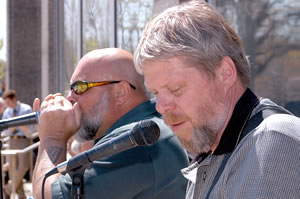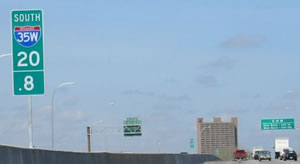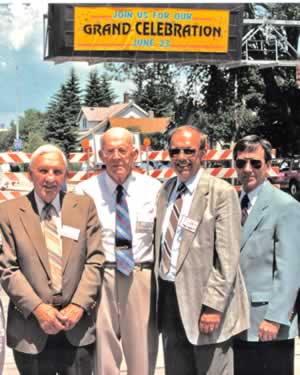 |
 |
|
 |
Employees honor fallen colleagues on Worker Memorial Day |
 |
 |
 |
|
At the Worker Memorial Day observance in St. Paul,
28 chairs were draped in safety vests and hard hats to symbolize Mn/DOT
workers who have been killed on the job. Another eight chairs containing
State Patrol hats signified fallen troopers. By David Gonzalez
|
Earl Held. Greg Nelson. Alan Larson. Albert Vasquez. Tom Schmit. These are
a few of the transportation workers Mn/DOT employees gathered statewide April
28 to remember as part of the annual Worker Memorial Day event.
Observed internationally, the event honors workers who have been injured or
killed on the job. Gov. Tim Pawlenty and Lt. Gov./Commissioner Carol Molnau
proclaimed April 28, 2004 as Worker Memorial Day in Minnesota.
In St. Paul, 36 chairs flanked the speakers’ podium in front of the Transportation
Building. Twenty-eight chairs were draped with safety vests and hard hats to
represent the Mn/DOT employees who lost their lives on the job since 1960; eight
chairs contained State Patrol hats symbolizing the troopers who have died in
work-related incidents.
The observance included remarks by Terry Schmitt, a transportation generalist
working in Rochester/District 6, who was seriously injured in 1998 when he was
plowing snow.
David Smith, a transportation generalist in Mn/DOT’s Metro District, received
recognition for his contributions to promote work zone safety and Worker Memorial
Day at Mn/DOT. In his 32-year state career, Smith experienced two work-related
accidents himself and has known co-workers and friends who were killed or injured
on the job.
"Dave’s passion for ensuring that we at Mn/DOT commemorate this day annually
has been unwavering," said Bob Winter, District Operations Division director,
who emceed the St. Paul event.
Smith said it is "an unending task" to raise public awareness about
work zone safety. In an informal survey he and colleagues took earlier this
week while on a job, Smith said they noted about 25 percent of drivers going
through their work zone were on cell phones, while others were eating or drinking.
 |
|
From left, Larry Cooper, Mankato/District 7 bridge
maintenance supervisor, and Mark Scheidel, Mankato/District 7 principal
planner, perform Bob Dylan’s "I Shall Be Released." By David
Gonzalez
|
Representatives from the Department of Public Safety, the Department of Labor
and Industry, and AFSCME Council 6, the union that represents highway workers,
also spoke.
Mike Buesing, AFSCME president, urged people to "mourn for the dead, but
fight for the living."
Larry Cooper, Mankato/District 7 bridge maintenance supervisor, and Mark Scheidel,
Mankato/District 7 principal planner, provided a musical tribute for the occasion,
performing Bob Dylan’s "I Shall Be Released" on guitar and harmonica.
A message from the lieutenant governor, who was observing Worker Memorial Day
events with District 3 employees at Camp Ripley, was broadcast at 2 p.m. at
Mn/DOT locations statewide. The message was accompanied by guitar music composed
and played by Kai Link, on mobility in Metro District.
Follow this link for additional information including a copy of the governor’s
proclamation, text of the commissioner's speech and names of employees who were
killed on the job: http://www.dot.state.mn.us/workzone/.
|
back

|
 |
New mile-markers on Minneapolis freeways help motorists pinpoint locations |
 |
 |
 |
|
This new mile-marker on I-35W provides additional
information that could help motorists describe their exact location when
seeking help following a crash, breakdown or other incident. Photo
by Brian Kary
|
Bright green mile-markers placed in the medians of two Twin Cities metro area
freeway corridors will help motorists describe their exact location when seeking
help following a crash, breakdown or other incident.
The markers display the roadway shield, direction of travel and the mile point
in increments of one-tenth of a mile. They are located on I-35W from 46th Street
to the Industrial Boulevard and on Hwy 65 from where it splits from I-35W near
Franklin Avenue and runs north into downtown Minneapolis. Both freeway sections
are in Minneapolis.
Jim Kranig, director of the Regional Transportation Management Center, said
the markers make it easier for motorists to report incident locations in areas
where accurate identification has been difficult to obtain.
"Emergency responders and motorists alike will benefit from the new mile-marker
designations because emergency vehicles can respond faster with precise incident
locations," he said.
Faster removal of vehicles involved in crashes or stalled cars leads to fewer
incident-related delays and secondary crashes, ensuring safer travel for freeway
users, Kranig said.
The new mile-makers join other traffic management tools such as cameras, ramp
meters, loop detectors and changeable message signs that enable Mn/DOT to better
manage the area’s busy freeways, he said.
By Craig Wilkins
|
back

|
 |
Workshop focuses on streamlining environmental reviews to keep pace with accelerated
construction program |
 |
 |
 |
|
Mark Seeley, University of Minnesota professor of climatology,
addresses a general session on climate and the environment. Photo by
Barb Bauer
|
Staff from Mn/DOT, other state and federal agencies and consultants met April
21-22 to determine how the department can remain an effective steward of the
environment as Mn/DOT accelerates its highway construction program.
Participants in the workshop on environmental stewardship and streamlining
the environmental review process examined issues such as erosion control, wetland
management and dealing with contaminated properties acquired for construction
purposes.
They also addressed the need to streamline the overall review process to match
Mn/DOT’s expanded construction program.
They found no simple answers. They did, however, reach consensus that each
agency needs to meet early in the planning process to establish mutual goals
and trust in order to avoid 11th hour crises, said Dick Elasky, Environmental
Services director.
Environmental Services held the workshop to bring project managers, designers,
engineers, hydrologists and environmental specialists together to examine issues
they share.
Todd Grugel, district hydraulics engineer at Detroit Lakes, said the sessions
he attended on the roles of regulatory agencies were a valuable part of the
workshop.
"Going to the sessions on the watershed districts, the Pollution Control
Agency, the Department of Natural Resources and the Corps of Engineers helped
me know where they’re coming from so we can reach solutions that work for all
parties," he said.
"The environmental aspect of projects is becoming more critical so it’s
more important than ever that we have up-front coordination."
Elasky said remarks by Deputy Commissioner Doug Differt and Dick Stehr, director
of Engineering Services, urged creating partnerships to reduce the likelihood
of delays in the review process and the projects themselves.
"It was exciting to see the number of agencies there," said Scott
Morgan, Mankato district hydraulics engineer. "By working together we can
manage projects better and get things done more efficiently."
Differt said, for example, that Mn/DOT needs to work more closely with local,
state and federal agencies when seeking permits for work that affects the state’s
lakes, rivers and wetlands by moving the review process "upstream"
to streamline the review process, reduce costs and keep the project on schedule.
Barb Bauer, a program manager with Environmental Services and a workshop planner,
said the event brought participants up to date with changing environmental rules
and regulations and emphasized the spirit of leaving an environmental legacy
for future generations.
"The workshop stressed meeting those regulations," she said, "but
also reflected the spirit of doing the right thing as responsible stewards of
the earth."
Bauer said the workshop will be held annually to further explore issues related
to the environment and program delivery.
Elasky said all the people involved in road planning, design and construction
need to stay current with the latest developments in environmental science and
project management.
"We need to become better stewards of the environment and move our projects
out the door more quickly," Elasky said.
By Craig Wilkins
|
back

|
 |
Mn/DOT earns pavement award for long-lasting section of Hwy 71 |
 |
 |
A 9.3-mile section of Hwy 71 between Park Rapids and the Hubbard County line
built in 1964 that still provides high-quality service earned a Perpetual Pavement
Award from the Asphalt Pavement Alliance.
Lynn Eaton, assistant district engineer for program delivery with District
2, accepted the award for the department at the alliance’s annual conference.
The section was constructed with hot-mix asphalt placed over an existing road,
which had a granular soil subgrade, a 4.5-inch aggregate base and a 1.5-inch
surface. The section was overlaid only once since it was completed nearly 40
years ago. Project contractor was Duininck Brothers, Inc., of Prinzburg.
Conference judges cited the project because of its ability to withstand the
state’s extreme climactic conditions, few signs of visible deterioration and
a high serviceability rating in spite of average daily traffic increasing from
1,410 in 1963 to 5,806 in 2002.
|
back

|
 |
Retired Duluth DE John Pawlak dies at 88 |
 |
 |
 |
|
John Pawlak (at left) posed for a picture in 1993 with his predecessor,
Lester Miller (immediate right), and two of his successors, John Sandahl
and Dave Ekern, at ceremonies marking rehabilitation of the John Blatnik
Bridge in Duluth. Photo by John Bray
|
John Pawlak, the former Duluth/District 1 district engineer, died April 20.
He was 88.
A funeral Mass will be held April 29 at 11 a.m. at St. Gregory’s Catholic Church
in North Branch. Visitation will be held for one hour before the Mass.
Pawlak’s career with Mn/DOT began in 1940.
He was appointed district engineer at Duluth in 1971 and served in that post
until his retirement in 1983. His career with Mn/DOT was interrupted by his
service as a Seabee with a U.S. Navy construction battalion during World War
2.
His tenure at District 1 was highlighted by the extension of I-35 through the
city. While the project was contentious at first, the results—which included
reducing traffic on the downtown surface streets and using the landscaped cover
over the freeway tunnels to connect the downtown area to the lakefront—earned
praise from all facets of the community.
Pawlak was respected by his peers for his experience, expertise and curiosity.
"John didn’t know me one bit but he would stop in the Bituminous Office
when I was the bituminous engineer once or twice every year," said Pat
Hughes, now the Metro district engineer. "His visits served to illustrate
how the Central Office helped the districts do their jobs and to find out what
we thought was important."
Dave Ekern, a successor of Pawlak’s at Duluth and now the director of the Idaho
Department of Transportation, said Pawlak left a legacy of dedicated public
service.
"As I reflect on John, he was truly representative of a generation of
leaders in the department who had a clear sense of the mission of building the
interstate system and ensuring the public investment was made at the best value,"
Ekern said.
"He had a no-nonsense approach to management and was always willing to
share what he thought on issues. He was committed to doing what he believed
to be the right thing to do and to hold the agency accountable for its commitments
to the citizens of the state."
He is preceded in death by his spouse, Faith Pawlak, parents, sisters and brothers.
His brother, Frank Pawlak, served as district engineer at Detroit Lakes from
1962 until 1974. He died in 1992.
John Pawlak’s survivors include two daughters and nephews and nieces.
By Craig Wilkins
|
back

|
 |
Correction: Aviation Hall of Fame honors Mn/DOT’s Dan McDowell |
 |
 |
Dan McDowell, a senior aviation planner with Aeronautics, received recognition
from the Minnesota Aviation Hall of Fame for his writing, which appears in aviation-related
publications.
McDowell earned a plaque citing him for authoring technical advisories for
Aeronautics and other material for the "Minnesota Flyer" and other
publications.
The award was presented to McDowell during ceremonies to induct new members
into the Hall of Fame on April 17.
It was reported incorrectly in the April 14 issue of Mn/DOT Newsline
that McDowell was inducted as a member of the Hall of Fame.
|
back

|
 |
|
 |



